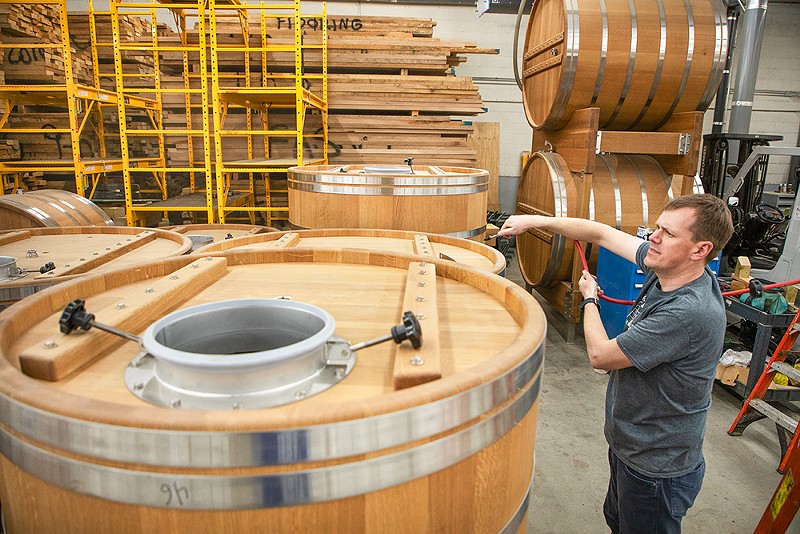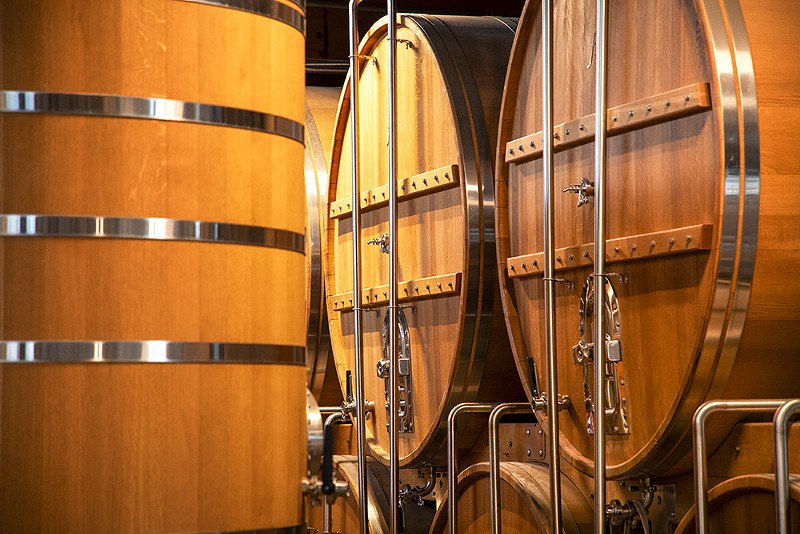From St. Louis, Foeder Crafters Uses Missouri Oak to Supply the Beer World
“Sure,” Walters is said to have replied. “What’s a foeder?”
Walters soon learned that a foeder (a Dutch word pronounced food-er) is a large wooden vessel used to age or ferment beer. Originally used by the French to produce wine, the foeder was adopted by Belgians in the 1800s for use in aging their sour ales. Fast forward about 200 years and American craft brewers getting into wild ales, sours and lambics were clamoring for oversized barrels. And, as Walters discovered, the best wood to make a foeder was oak, particularly the Missouri white oak that was plentiful right in his backyard.
Walters’ work on that first foeder impressed Heavy Riff co-owner Justin Saffell — and plenty of other area brewers — enough for Saffell to convince Walters to start a business together. Today, Foeder Crafters of America (10844 Indian Head Industrial Boulevard, foedercrafters.com) is the largest American manufacturer of the vessels in the world, with their handcrafted foeders featured in more than 500 brewhouses, wineries, cideries and distilleries on five continents.
“We make them differently than they do in Europe,” says Saettele, a former loan officer who worked with Walters before buying the company from him in 2020. “[Walters] didn’t have the knowledge or baggage of history; he just made them the way he thought they should be made.”
Traditionally, foeders have been made like barrels — using flat-side staves that are simply pressed and held together with the metal hoops and pressure. But Foeder Crafters instead uses interlocking finger-jointed staves, which make the vessel air-tight, essentially as if it was one solid piece of wood.
The other key differentiator in Foeder Crafters’ wares is the type of wood. Missouri is the country’s most prodigious producer of white oak, a hardwood that endures at least 80 years of the state’s harshest winters and most brutal summers before being ready for harvest. Oak also undergoes a unique decaying process called tylosis, where the wood cells swell up to fill gaps in the growth rings, making the wood practically leak-proof. Plus, Missouri white oak imbues liquid with spices, like vanilla, and a toastiness that winemakers, distillers and brewers all over the world covet for their respective concoctions.
The oak used by Foeder Crafters has been air-dried for at least two years. The staves are then cut, assembled and steamed. They also usually char the interior at least a little just to get rid of the pungent “green” of raw oak. The foeders range in size from 500 liters to 10,000 gallons, $8,000 to $75,000, and come in either horizontal models that sit in racks like wine barrels or vertical ones, which resemble a typical stainless vat with a conical bottom that makes it easier to clean.
Foeders initially hit the beer scene because they were ideal for aging mixed-culture fermentation beers that use wild yeasts and lactic acid bacteria, like sours and wild ales, but brewers have started using them for just about anything. For instance, Florissant’s Narrow Gauge has been prolific in offering slightly funkier, foeder-aged versions of their IPAs and pale ales. And Saettele says that lately, brewers all over have been using Missouri oak to put a different spin on their lagers.
“The wood gives a lager a more pillowing mouth feel,” he says. “A foeder-aged lager is much softer.”
So, no matter where you are in the U.S. or even sometimes abroad, when you see “foeder-aged” on a beer can or wine or whiskey bottle, or walk into a brewery and see the pale wooden vessel, you can bet that it comes from Saettele’s St. Louis factory.
“I love walking into a brewery wearing my Foeder Crafter t-shirt,” he says. “When brewers see it, they treat us like rock stars.”
Subscribe to Riverfront Times newsletters.
Follow us: Apple News | Google News | NewsBreak | Reddit | Instagram | Facebook | Twitter | Or sign up for our RSS Feed





Comments are closed.